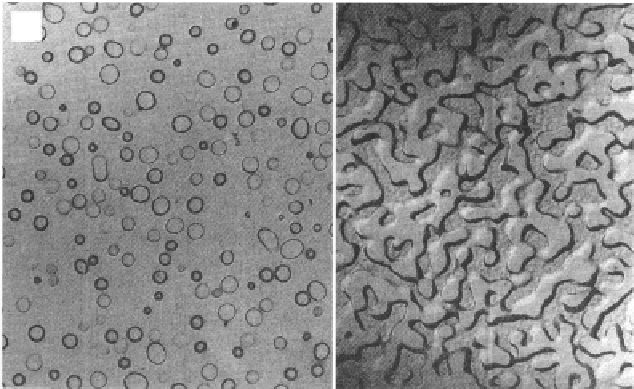Biomedical Engineering Reference
In-Depth Information
(a)
(b)
Figure 12.9.
Microstructure of (a) soda lime silica glass heated at 740 °C for 7.25 h(14,000
×
)
showing nucleated droplet phase separation, and (b) “Vycor” glass heated at 700 °C for
5.5 h(24,000
) showing spinodal decomposition [60].
×
phases are liquid, then the phase separation is called liquid-liquid immiscibility.
The immiscibility can be stable or metastable, depending on whether the phase
separation occurs at temperatures above the liquidus or below the liquidus,
respectively. This metastable immiscibility is of great interest. There are two routes
that lead to the formation of discrete phases by a metastable phase separation; the
nucleation and growth mechanism [19, 58-61] and the spinodal decomposition
[19, 60, 62]. Figure 12.9 shows the microstructure of a) a soda lime silica glass
heated at 740 °C for 7.25 h showing nucleated droplet phase separation and b) a
“Vycor” glass heated at 700 °C for 5.5 hours showing spinodal decomposition [60].
The differences between these two processes are clear. During the nucleation
and growth mechanism the second phase composition does not change with time
at constant temperature, the interface between phases retains the degree of
sharpness during growth, the particle sizes and positions are randomly distributed
and the second phase consists of spherical particles with very low connectivity. On
the other hand, during spinodal decomposition, there is a variation of phase com-
positions with time until equilibrium compositions are reached, the interface
between phases is diffuse and eventually sharpens, the second phase distribution
is regular and characterised by geometric spacing and the second phase consists
of non-spherical particles with high connectivity [60].
The view that crystallisation occurs via prior amorphous phase separation
(APS) in ionomer glasses is evidenced by the optimum nucleation temperatures
being close to the experimentally determined glass transition temperatures and
the presence of two loss peaks in dynamic mechanical thermal analysis experi-
ments on nucleated (phase separated) glasses [63]. The two loss peaks were
thought to correspond to two different glass transition temperatures associated

Search WWH ::

Custom Search